Periodontal Flap Definition
Periodontal Flap: Periodontal Flap is a section of the gingiva and/or the mucosa surgically separated from the underlying tissues to provide visibility and access to the bone and the root surface
Periodontal Flap Important Notes
1. Basic requirements of flap
- It should provide adequate exposure to the surgical area
- The flap must have a broad base and good vascular supply
- When placed back after surgery flap should rest on healthy bone
Read And Learn More: Periodontics Question and Answers
2. Advantages of the flap technique
- Provides adequate visibility and accessibility to the root deposit
- Eliminates or reduces pocket depth
- Expose the area to perform regenerative procedures
3. Condition and the preferred flap

4. Apically displaced flap
- It can be used for pocket elimination or widening the zone of attached gingival
- The pocket wall is transformed into an attached gingival
- It increases the length of the clinical crown and is not indicated for palatal pockets
- The width of the attached gingiva is increased by approximately half the pretreatment pocket depth
Modified Widman Flap
Periodontal Flap Long Essays
Question 1. Define periodontal flap. Classify and describe in detail the modified Widman flap.
Answer:
Periodontal Flap:
Periodontal Flap is a section of the gingiva and/or the mucosa surgically separated from the underlying tissues to provide visibility and access to the bone and the root surface
Classification of Periodontal Flap:
- According to the thickness of the flap
- Full thickness flap
- Partial thickness flap
- According to the placement of the flap
- Non displaced flap
- Displaced flap
- According to the design of the flap
- Conventional flap
- Papilla Preservation flap
Modified Widman Flap:
- By Ramfjord and Nissle
Periodontal Flap Indication:
- Accessibility to root surfaces
- Pocket lining removal
Periodontal Flap Technique:
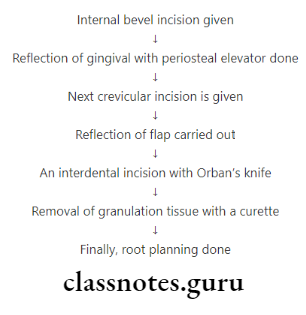
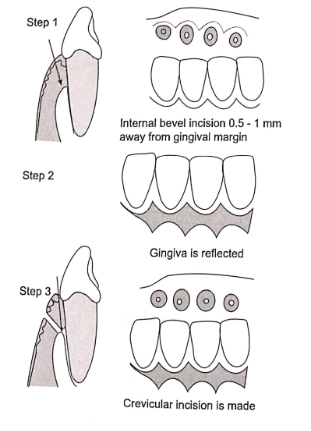

Periodontal Flap Short Essays
Question 1. Classification of periodontal flaps.
Answer:
According to Thickness of Flap
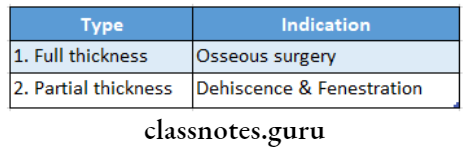
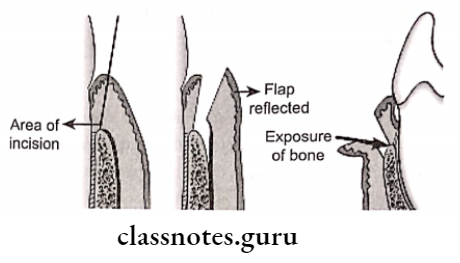

According to the placement of Flap
- Non-displaced flap:
- The flap is returned and sutured in its original position
- Displaced flap:
- The flap is placed apically, coronally, or laterally to its original position.
According to the management of the papilla
- Conventional flap:
- The interdental papilla is split beneath the contact point between the teeth
- Modified Widman flap is a conventional flap
- Indications:
- Narrow interdental area
- Papilla preservation flap:
- It incorporates the entire papilla
- Indications:
- Esthetics
- Regenerative procedures
Question 2. Types of periodontal flap surgical procedures for pocket therapy. Describe the apically displaced flap.
Answer:
Periodontal Flap:
- Periodontal Flap is a section of the gingiva and/or the mucosa surgically separated from the underlying tissues to provide visibility and access to the bone and root surface
Periodontal Flap Types Of Flap For Pocket Therapy:
- Modified Widman flap
- Undisplaced flap
- Apically displaced flap
Periodontal Flap Apically Displaced Flap:
- Periodontal Flap is described by Friedman
Periodontal Flap Indications:
- Elimination of pocket
- Better accessibility
- Widening of attached gingiva
Periodontal Flap Technique:

Flap Surgery
Question 3. Classify periodontal flaps and give indications of periodontal flap surgery.
Answer:
Periodontal flap surgery:
Periodontal Flap Surgery is a section of the gingiva and/or the mucosa surgically separated from the underlying tissues to provide visibility and access to the bone and root surface
Classification of periodontal flap surgery:
1. According to the thickness of the flap
- Full thickness flap
- Partial thickness flap
2. According to the placement of the flap
- Non displaced flap
- Displaced flap
3. According to the design of the flap
- Conventional flap
- Papilla preservation flap
Periodontal Flap Surgery Indications Of Flap Surgery
- To increase accessibility to root deposits
- To eliminate or reduce pocket depth by resectioning the pocket wall
- To expose the area to perform regenerative methods
- To reshape soft and hard tissues to physiologic architecture
Question 4. Apically Displaced flap.
Answer:
By Friedman
Displaced flap Indications:
- Elimination of pocket
- Better accessibility
- Widening of attached gingiva
Displaced flap Technique:

Question 5. Incisions.
Answer:
Horizontal incision:
1. Internal bevel incision:
- Extend: Marginal gingiva to the bone crest
- Synonyms: First incision
- Reverse bevel incision
- Advantages: Eliminates pocket
- Preserves remaining structures
- Provides good adaptation of tooth-to-bone
- The blade used: No. 15 and 11 – surgical scalpels
2. Crevicular incision:
- Second incision
- Extend – Base of the pocket to the crest of bone
- Blade – No.12B
- Effect – Formation of tissue wedge
Interdental incision:
- Third incision
- Purpose to separate the collar of the gingiva
- An instrument used – Orban knife
Vertical Incision:
- On either side of the horizontal incision
- Extend – Beyond the mucogingival junction
- Indications: Displaced flap
- Isolated deep pockets

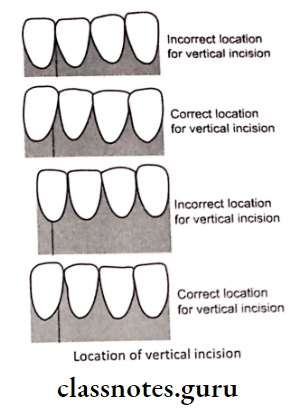
Periodontal Flap Definition Short Question And Answers
Question 1. Envelope flap.
Answer:
Envelope Flap with only a horizontal incision without any releasing incisions given is called an envelope flap
Indication: Undisplaced flap
Question 2. Indications of Flap Surgery.
Answer:
- Root debridement
- Pocket elimination
- Reshaping of tissue
- Regenerative procedures
Question 3. Papilla Preservation flap.
Answer:
Reservation Flap by Takei et. Al and Cortellini
Reservation flap Technique:


Reservation flap Advantages:
- Esthetic
- No root exposure
- No post-operative sensitivity
Question 4. Healing after flap surgery.
Answer:

Question 5. Name horizontal incisions for flap surgery.
Answer:
1. Internal bevel incision:
- Internal bevel incision extends from the marginal gingiva to the bone crest
Flap surgery Synonym:
- First incision
- Reverse bevel incision
Flap surgery Advantages:
- Eliminates pocket
- Preserves remaining structures
- Provides good adaptation of tooth to the bone
Flap surgery Blade Used:
- No. 15 and 11, surgical scalpels
2. Crevicular incision:
- The crevicular incision is the second incision
- Crevicular incision extends from the base of the pocket to the crest of the bone
Flap surgery Blade Used:
- No 12B is used
Flap surgery Effect:
- It leads to the formation of tissue wedge
3. Interdental incision:
- It is the third incision
- It is used to separate the collar of the gingiva
Flap surgery Instrument Used:
- Orban knife
Question 7. Two advantages and disadvantages of lateral pedicle graft.
Answer:
Lateral pedicle graft Advantages:
- One surgical site
- Good vascularity
Lateral pedicle graft Disadvantages:
- Risk of gingival recession at the donor site
- Dehiscence or fenestration at the donor site
Question 8. Indications and contraindications of lateral pedicle graft.
Answer:
Lateral pedicle graft Indications:
- Isolated denuded root
- Sufficient vestibular depth
- Sufficient width of interdental papilla
Lateral pedicle graft Contraindications:
- Deep pockets
- Prominent root surfaces
- Loss of interproximal bone
Periodontal Flap Viva Voce
- Apically displaced flaps cannot be performed in the palatal aspect of maxillary posterior teeth
- Unattached gingiva is absent in the palatal aspect of maxillary posterior teeth
- Widening of the attached gingiva as well as pocket elimination is accomplished by apically displaced flap
- An internal bevel incision is also called a reverse bevel incision
- The second incision in the periodontal flap is a crevicular incision
- The interdental incision is called the third incision
- After flap surgery fully epithelized gingival crevice occurs after 1 month.
- An undisplaced flap is essentially an excisional procedure of the gingival
